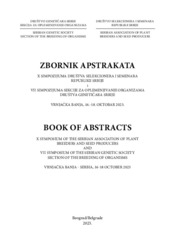Uticaj dužine vegetacije genotipa i datuma setve na pokrovnost useva suncokreta
The influence of genotype vegetation length and sowing date on sunflower crop canopy
| dc.creator | Babec, Brankica | |
| dc.creator | Krstić, Miloš | |
| dc.creator | Ćuk, Nemanja | |
| dc.creator | Ovuka, Jelena | |
| dc.creator | Gvozdenac, Sonja | |
| dc.creator | Jocić, Siniša | |
| dc.creator | Cvejić, Sandra | |
| dc.date.accessioned | 2023-11-11T16:40:14Z | |
| dc.date.available | 2023-11-11T16:40:14Z | |
| dc.date.issued | 2023 | |
| dc.identifier.isbn | 978-86-87109-17-9 | |
| dc.identifier.uri | http://fiver.ifvcns.rs/handle/123456789/3985 | |
| dc.description.abstract | Različiti vremenski okviri setve i karakteristike genotipova značajno utiču na varijacije u pokrovnosti useva suncokreta. Istraživanja ukazuju na mogućnost optimizacije pokrovnosti useva putem prilagođavanja datuma setve i odabira genotipa, posebno uzimajući u obzir dužinu vegetacije. Razvijeniji habitus biljke može značajno olakšati proces kontrole korova u suncokretu, pružajući veću pokrovnost, koja sprečava dalji rast korova. Cilj ovog rada bio je da se ispita pokrovnost tri inbred linije suncokreta različite dužine vegetacije: ultra rana, srednje rana i kasna i njihov habitus kroz četiri različita roka setve i četiri perioda merenja: 30, 40, 50 i 60 dana nakon nicanja. Korišćenjem aplikacije „CANAPEO“, sprovedeno je detaljno merenje habitusa biljke suncokreta. Analiza varijanse korišćena je da bi se uočile razlike između habitusa kod različitih inbred linija, datuma setve i datuma merenja. Primećeno je da su inbred linije, datum setve i njihova interkacija imali značajan uticaj na habitus biljke tokom većine perioda merenja. Analiza rezultata pokazuje da nakon 30, 40, 50 i 60 dana od nicanja, poslednji rok setve i srednje rana inbred linija u proseku ostvaruje najveći habitus biljke, odnosno pokrovnost useva suncokreta. Srednje rana inbred linija sucnokreta nakon 60 dana od nicanja pokriva više od 99% površine zemlje i ne dopušta dalji rast korova. Može se zaključiti da primenom fenotipske analize habitusa biljke postoji mogućnost za efikasnije suzbijanje korova. Takođe, ističe se da uz pomeranje datuma setve prema kasnijem, dolazi do brže i efikasnije pokrovnosti tla ispod svih inbred linija suncokreta, što doprinosi efikasnom suzbijanju rasta korova. | sr |
| dc.description.abstract | Different sowing dates and genotype characteristics significantly influence variations in sunflower canopy. Various studies indicate the potential for optimizing crop canopy through adjusted sowing times and genotype selection, particularly considering vegetation length. A more developed plant habitus can considerably facilitate weed control in sunflower fields, providing enhanced coverage that impedes further weed growth. The aim of this study was to examine the coverage of three different sunflower inbred lines with varying vegetation lengths: ultra-early, mid-early, and late, across four different sowing dates and four measurement periods: 30, 40, 50, and 60 days after emergence. Through the utilization of the “CANAPEO” application, a comprehensive measurement of sunflower plant habitus was conducted. Analysis of variance was employed to discern differences in habitus among different inbred lines, sowing dates, and measurement periods. It was observed that inbred lines, sowing dates, and their interaction significantly impacted plant habitus throughout most measurement periods. The results indicated that 30, 40, 50, and 60 days post-emergence, last sowing date and mid-early inbred line on average achieved the biggest habitus i.e. crop canopy. The mid-early inbred line covered over 99% of the ground surface after 60 days from emergence, preventing further weed growth. In conclusion, the application of phenotypic analysis of plant habitus presents an opportunity for efficient weed suppression. Additionally, shifting the sowing date towards later periods results in faster and more effective soil coverage beneath all sunflower inbred lines, contributing to effective weed growth inhibition. | sr |
| dc.language.iso | sr | sr |
| dc.publisher | Beograd : Društvo genetičara Srbije | |
| dc.publisher | Beograd : Društvo selekcionera i semenara Srbije | |
| dc.relation | info:eu-repo/grantAgreement/MESTD/inst-2020/200032/RS// | sr |
| dc.relation | info:eu-repo/grantAgreement/ScienceFundRS/Ideje/7732457/RS// | sr |
| dc.relation | info:eu-repo/grantAgreement/EC/HE/101059784/EU// | sr |
| dc.relation | Climate Crops - Centre of Excellence for Innovations in Breeding of Climate-Resilient Crops, Institute of Field and Vegetable Crops | |
| dc.rights | openAccess | sr |
| dc.rights.uri | https://creativecommons.org/licenses/by/4.0/ | |
| dc.source | Zbornik apstrakata, 10. Simpozijum Društva selekcionera i semenara Republike Srbije i 7. Simpozijum Sekcije za oplemenjivanje organizama Društva genetičara Srbije, Vrnjačka Banja, 16-18.10.2023. | sr |
| dc.subject | inbred linija suncokreta | sr |
| dc.subject | pokrovnost | sr |
| dc.subject | datum setve | sr |
| dc.subject | sunflower inbred line | sr |
| dc.subject | canopy | sr |
| dc.subject | sowing date | sr |
| dc.title | Uticaj dužine vegetacije genotipa i datuma setve na pokrovnost useva suncokreta | sr |
| dc.title | The influence of genotype vegetation length and sowing date on sunflower crop canopy | sr |
| dc.type | conferenceObject | sr |
| dc.rights.license | BY | sr |
| dc.citation.epage | 150 | |
| dc.citation.spage | 149 | |
| dc.identifier.fulltext | http://fiver.ifvcns.rs/bitstream/id/9687/bitstream_9687.pdf | |
| dc.identifier.rcub | https://hdl.handle.net/21.15107/rcub_fiver_3985 | |
| dc.type.version | publishedVersion | sr |


